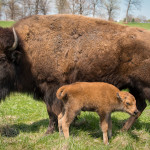Spring has arrived and, with it, the newest four-legged addition to the Fermilab community.
A bison calf was born early on Saturday, April 25, at Fermilab. About 12 more calves are expected this spring. The U.S. Department of Energy’s Fermi National Accelerator Laboratory welcomes the public to come see the latest addition to its herd of American bison.
Visitors, including families with young children, can enter the Fermilab site through its Pine Street entrance in Batavia or the Batavia Road entrance in Warrenville. Admission is free, but you will need a valid photo ID to enter the site. Summer hours are from 8 a.m. to 8 p.m., seven days a week.
Visitors can also explore the exhibit and viewing areas on the 15th floor of Wilson Hall by signing in at the reception desk Monday to Friday from 8 a.m. to 4:30 p.m. and Saturday to Sunday from 9 a.m. to 3 p.m.
Fermilab’s first director, Robert Wilson, established the bison herd in 1969 as a symbol of the history of the Midwestern prairie and the laboratory’s pioneering research at the frontiers of particle physics. The herd remains a major attraction for families and wildlife enthusiasts. Today, the Fermilab site boasts seven particle accelerators for use by thousands of researchers around the world, as well as 1,100 acres of reconstructed tallgrass prairie. The U.S. Department of Energy designated the 6,800-acre Fermilab site a National Environmental Research Park in 1989.
Visitors can learn more about nature at Fermilab by hiking the Interpretive Prairie Trail, a half-mile-long trail located near the Pine Street entrance. The Leon Lederman Science Education Center offers exhibits on the prairie and hands-on physics displays. The Lederman Center hours are Monday-Friday from 8:30 a.m. to 4:30 p.m. and Saturdays from 9 a.m. to 3 p.m.
For up-to-date information for visitors, please visit http://www.fnal.gov/pub/visiting/ or call 630-840-3351.
To learn more about Fermilab’s bison herd, please visit our Web page on the bison herd.
Fermilab is America’s premier national laboratory for particle physics and accelerator research. A U.S. Department of Energy Office of Science laboratory, Fermilab is located near Chicago, Illinois, and operated under contract by the Fermi Research Alliance LLC. Visit Fermilab’s website at www.fnal.gov and follow us on Twitter at @Fermilab.
The DOE Office of Science is the single largest supporter of basic research in the physical sciences in the United States and is working to address some of the most pressing challenges of our time. For more information, please visit science.energy.gov.
- Photo: Fermilab
- Photo: Fermilab
- Photo: Fermilab
The Italian experiment – the world’s largest of its type – will become an integral part of the future of neutrino research in the United States
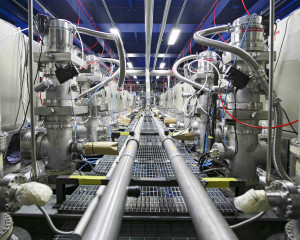
A view of the top of the ICARUS detector in place at INFN’s Gran Sasso National Laboratory in Italy. The 760-ton detector has been removed from Gran Sasso and shipped to CERN for upgrades, and will come to Fermilab in 2017 to become part of the laboratory’s short-baseline neutrino program. Photo: INFN
A group of scientists led by Nobel laureate Carlo Rubbia will transport the world’s largest liquid-argon neutrino detector across the Atlantic Ocean to its new home at the U.S. Department of Energy’s Fermi National Accelerator Laboratory.
The 760-ton, 65-foot-long detector took data for the ICARUS experiment at the Italian Institute for Nuclear Physics’ (INFN) Gran Sasso National Laboratory in Italy from 2010 to 2014, using a beam of neutrinos sent through the Earth from CERN. The detector is now being refurbished at CERN, where it is the first beneficiary of a new test facility for neutrino detectors.
When it arrives at Fermilab, the detector will become part of an on-site suite of three experiments dedicated to studying neutrinos, ghostly particles that are all around us but have given up few of their secrets.
All three detectors will be filled with liquid argon, which enables the use of state-of-the-art time projection technology, drawing charged particles created in neutrino interactions toward planes of fine wires that can capture a 3-D image of the tracks those particles leave. Each detector will contribute different yet complementary results to the hunt for a fourth type of neutrino.
“The liquid-argon time projection chamber is a new and very promising technology that we originally developed in the ICARUS collaboration from an initial table-top experiment all the way to a large neutrino detector,” Rubbia said. “It is expected that it will become the leading technology for large liquid-argon detectors, with its ability to record ionizing tracks with millimeter precision.”
Fermilab operates two powerful neutrino beams and is in the process of developing a third, making it the perfect place for the ICARUS detector to continue its scientific exploration. Scientists plan to transport the detector to the United States in 2017.
A planned sequence of three liquid-argon detectors will provide new insights into the three known types of neutrinos and seek a yet unseen fourth type, following hints from other experiments over the past two decades.
Many theories in particle physics predict the existence of a so-called “sterile” neutrino, which would behave differently from the three known types and, if it exists, could provide a route to understanding the mysterious dark matter that makes up 25 percent of the universe. Discovering this fourth type of neutrino would revolutionize physics, changing scientists’ picture of the universe and how it works.
“The arrival of ICARUS and the construction of this on-site research program is a lofty goal in itself,” said Fermilab Director Nigel Lockyer. “But it is also the first step forward in Fermilab’s plan to host a truly international neutrino facility, with the help of our partners from around the world. The future of neutrino research in the United States is bright.”
Fermilab’s proposed suite of experiments includes a new 260-ton Short Baseline Neutrino Detector (SBND), which will sit closest to the source of the particle beam. This detector is under construction by a team of scientists and engineers from universities and national laboratories in the United States and Europe.
The neutrino beam will then encounter the already-completed 170-ton MicroBooNE detector, which will begin operation next year. The final piece is the ICARUS detector, which will be housed in a new building to be constructed on site.
Construction on the ICARUS and SBND buildings is scheduled to begin later this year, and the three experiments should all be operational by 2018. The three collaborations include scientists from 45 institutions in six countries.
The move of the ICARUS detector is a sterling example of cooperation between countries (and between three scientific collaborations) to achieve a global physics goal. The current European strategy for particle physics, adopted by the CERN Council, recommends that Europe play an active part in neutrino experiments in other parts of the world, rather than carry them out at CERN.
The U.S. particle physics community has adopted the P5 (Particle Physics Project Prioritization Panel) plan, which calls for a world-class long-distance neutrino facility to be built at Fermilab and operated by an international collaboration. Fermilab, CERN, INFN and many other international institutions are expected to partner in this endeavor.
Knowledge gained by operating the suite of three liquid-argon experiments will be important in the development of the DUNE experiment at the planned long-distance facility at Fermilab. DUNE will be the largest neutrino oscillation experiment ever built, sending particles 800 miles from Fermilab to a 40,000-ton liquid-argon detector at the Sanford Underground Research Facility in South Dakota. For more information, read this article from symmetry magazine.
“The journey of ICARUS from Italy to CERN to the U.S. is a great example of the global planning in particle physics,” said CERN Director General Rolf Heuer. “U.S. participation in the LHC and European participation in Fermilab’s neutrino program are integral parts of both European and U.S. strategies. I am pleased that CERN has been able to provide the glue that is allowing DUNE to get off the ground with the transport of ICARUS.”
“The ICARUS T600 is the only detector in the world with more than 600 tons of argon to have been successfully operated,” said INFN’s deputy president Antonio Masiero “ICARUS uses a high-precision, innovative technique to detect neutrinos artificially produced in an accelerator. This technique, developed at INFN and first successfully put into operation in the ICARUS experiment at the INFN’s Gran Sasso National Laboratory, will make in the new dedicated facility at Fermilab a fundamental contribution to neutrino research.”
Fermilab is America’s premier national laboratory for particle physics and accelerator research. A U.S. Department of Energy Office of Science laboratory, Fermilab is located near Chicago, Illinois, and operated under contract by the Fermi Research Alliance, LLC. Visit Fermilab’s website at www.fnal.gov and follow us on Twitter at @Fermilab.
The DOE Office of Science is the single largest supporter of basic research in the physical sciences in the United States and is working to address some of the most pressing challenges of our time. For more information, please visit science.energy.gov.
CERN, the European Organization for Nuclear Research, is the world’s leading laboratory for particle physics. It has its headquarters in Geneva. At present, its Member States are Austria, Belgium, Bulgaria, the Czech Republic, Denmark, Finland, France, Germany, Greece, Hungary, Israel, Italy, the Netherlands, Norway, Poland, Portugal, Slovakia, Spain, Sweden, Switzerland and the United Kingdom. Romania is a Candidate for Accession. Serbia is an Associate Member in the pre-stage to Membership. India, Japan, the Russian Federation, the United States of America, Turkey, the European Union, JINR and UNESCO have Observer Status.
The Italian Institute for Nuclear Physics (INFN) manages and supports theoretical and experimental research in the fields of subnuclear, nuclear, astroparticle physics in Italy under the supervision of the Ministry of Education, Universities and Research (MIUR). INFN carries out research activities at four national laboratories, in Catania, Frascati, Legnaro and Gran Sasso and 20 divisions, based at university physics departments in different cities of Italy. www.infn.it and on Twitter @UffComINFN
- A view of the top of the ICARUS detector in place at INFN’s Gran Sasso National Laboratory in Italy. The 760-ton detector has been removed from Gran Sasso and shipped to CERN for upgrades. It will come to Fermilab in 2017 to become part of the laboratory’s short-baseline neutrino program. Photo: INFN
- The ICARUS detector in use at INFN’s Gran Sasso National Laboratory in Italy. The 760-ton detector is the largest liquid-argon time projection chamber in the world, technology that was pioneered in Italy. The ICARUS detector will be transported to Fermilab in 2017 to become part of the laboratory’s short-baseline neutrino program. Photo: INFN
- The 760-ton ICARUS detector on the road from Gran Sasso National Laboratory in Italy to CERN outside Geneva, Switzerland, in December 2014. The detector will be upgraded at CERN before being transported to Fermilab in 2017. Photo: INFN
- The 170-ton MicroBooNE liquid-argon neutrino detector, in place at Fermilab. The detector was designed to pin down anomalies in its predecessor experiment, MiniBooNE, and is expected to begin operation later this year. Photo: Fermilab
- The MicroBooNE detector moves from its original location on the Fermilab site to its new building in the path of one of the laboratory’s powerful neutrino beams. MicroBooNE will serve as the “middle” detector in Fermilab’s on-site short-baseline suite of experiments and will join its two comrades, ICARUS and SBND, in the search for a theorized fourth neutrino. Photo: Fermilab
- An artist’s rendering of the planned Short Baseline Near Detector (SBND), a 260-ton liquid-argon detector that will sit closest to the neutrino beam in Fermilab’s suite of on-site neutrino experiments. Construction on the buildings that will house ICARUS and SBND is expected to begin later this year. Image: Fermilab
- This rendering shows the layout of the planned suite of short-baseline neutrino experiments at Fermilab. The neutrino beam will be directed westward, traveling through the near detector (SBND), the MicroBooNE detector and finally the far detector (ICARUS). These three experiments will work together to search for a theorized fourth neutrino, a discovery that would change scientists’ picture of the universe and how it works. Image: Fermilab

More than 140 professionals in the science, technology, engineering and mathematics fields are scheduled to attend Fermilab’s STEM Career Expo on Wednesday, April 22. Photo: Fermilab
What does a scientist actually do all day? How difficult is it to be a mechanical engineer? What jobs could I get if I major in mathematics? What is the daily life of a computer technician really like?
On Wednesday, April 22, from 5:30 to 8:30 p.m., the U.S. Department of Energy’s Fermi National Accelerator Laboratory will offer high school students a valuable opportunity to ask those questions in person. The annual Science, Technology, Engineering and Mathematics (STEM) Career Expo, held in the atrium of Wilson Hall, will put those students face to face with people actually doing the jobs they will be applying for in the coming years.
In addition to Fermilab scientists and engineers, the STEM Career Expo will feature professionals from several local companies and research organizations who will be on hand to explain what they do. But this is not a college or job fair and is not about recruiting, according to organizer Susan Dahl of the Fermilab Education Office.
Rather, she said, this is a chance for students to talk one on one with professionals working in their fields of interest. The expo will also include five panel discussions on STEM-related topics, with an opportunity for students to ask questions.
“We hope students come away with a new view of the possibilities of finding careers in these fascinating fields and a more realistic idea of the individuals working in these very relevant and fascinating jobs,” Dahl said.
The STEM Career Expo is free and open to all high school students. The event is a collaborative event organized by the Fermilab Education Office and educators and career specialists from Kane and DuPage county schools. Sponsors include Fermilab Friends for Science Education, Batavia High School, Geneva Community High School and Valley Education for Employment System.
Fermilab is America’s premier national laboratory for particle physics and accelerator research. A U.S. Department of Energy Office of Science laboratory, Fermilab is located near Chicago, Illinois, and operated under contract by the Fermi Research Alliance LLC. Visit Fermilab’s website at www.fnal.gov and follow us on Twitter at @Fermilab.
The DOE Office of Science is the single largest supporter of basic research in the physical sciences in the United States and is working to address some of the most pressing challenges of our time. For more information, please visit science.energy.gov.
Analysis will help scientists understand the role that dark matter plays in galaxy formation
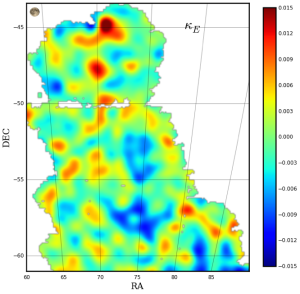
This is the first Dark Energy Survey map to trace the detailed distribution of dark matter across a large area of sky. The color scale represents projected mass density: red and yellow represent regions with more dense matter. The dark matter maps reflect the current picture of mass distribution in the universe where large filaments of matter align with galaxies and clusters of galaxies. Clusters of galaxies are represented by gray dots on the map – bigger dots represent larger clusters. This map covers three percent of the area of sky that DES will eventually document over its five-year mission. Image: Dark Energy Survey
Scientists on the Dark Energy Survey have released the first in a series of dark matter maps of the cosmos. These maps, created with one of the world’s most powerful digital cameras, are the largest contiguous maps created at this level of detail and will improve our understanding of dark matter’s role in the formation of galaxies. Analysis of the clumpiness of the dark matter in the maps will also allow scientists to probe the nature of the mysterious dark energy, believed to be causing the expansion of the universe to speed up.
The new maps were released today at the April meeting of the American Physical Society in Baltimore, Maryland. They were created using data captured by the Dark Energy Camera, a 570-megapixel imaging device that is the primary instrument for the Dark Energy Survey (DES).
Dark matter, the mysterious substance that makes up roughly a quarter of the universe, is invisible to even the most sensitive astronomical instruments because it does not emit or block light. But its effects can be seen by studying a phenomenon called gravitational lensing – the distortion that occurs when the gravitational pull of dark matter bends light around distant galaxies. Understanding the role of dark matter is part of the research program to quantify the role of dark energy, which is the ultimate goal of the survey.
This analysis was led by Vinu Vikram of Argonne National Laboratory (then at the University of Pennsylvania) and Chihway Chang of ETH Zurich. Vikram, Chang and their collaborators at Penn, ETH Zurich, the University of Portsmouth, the University of Manchester and other DES institutions worked for more than a year to carefully validate the lensing maps.
“We measured the barely perceptible distortions in the shapes of about 2 million galaxies to construct these new maps,” Vikram said. “They are a testament not only to the sensitivity of the Dark Energy Camera, but also to the rigorous work by our lensing team to understand its sensitivity so well that we can get exacting results from it.”
The camera was constructed and tested at the U.S. Department of Energy’s Fermi National Accelerator Laboratory and is now mounted on the 4-meter Victor M. Blanco telescope at the National Optical Astronomy Observatory’s Cerro Tololo Inter-American Observatory in Chile. The data were processed at the National Center for Supercomputing Applications at the University of Illinois in Urbana-Champaign.
The dark matter map released today makes use of early DES observations and covers only about three percent of the area of sky DES will document over its five-year mission. The survey has just completed its second year. As scientists expand their search, they will be able to better test current cosmological theories by comparing the amounts of dark and visible matter.
Those theories suggest that, since there is much more dark matter in the universe than visible matter, galaxies will form where large concentrations of dark matter (and hence stronger gravity) are present. So far, the DES analysis backs this up: The maps show large filaments of matter along which visible galaxies and galaxy clusters lie and cosmic voids where very few galaxies reside. Follow-up studies of some of the enormous filaments and voids, and the enormous volume of data, collected throughout the survey will reveal more about this interplay of mass and light.
“Our analysis so far is in line with what the current picture of the universe predicts,” Chang said. “Zooming into the maps, we have measured how dark matter envelops galaxies of different types and how together they evolve over cosmic time. We are eager to use the new data coming in to make much stricter tests of theoretical models.”
View the Dark Energy Survey analysis.
The Dark Energy Survey is a collaboration of more than 300 scientists from 25 institutions in six countries. Its primary instrument, the Dark Energy Camera, is mounted on the 4-meter Blanco telescope at the National Optical Astronomy Observatory’s Cerro Tololo Inter-American Observatory in Chile, and its data is processed at the National Center for Supercomputing Applications at the University of Illinois at Urbana-Champaign.
Funding for the DES Projects has been provided by the U.S. Department of Energy Office of Science, the U.S. National Science Foundation, the Ministry of Science and Education of Spain, the Science and Technology Facilities Council of the United Kingdom, the Higher Education Funding Council for England, ETH Zurich for Switzerland, the National Center for Supercomputing Applications at the University of Illinois at Urbana-Champaign, the Kavli Institute of Cosmological Physics at the University of Chicago, Financiadora de Estudos e Projetos, Fundação Carlos Chagas Filho de Amparo à Pesquisa do Estado do Rio de Janeiro, Conselho Nacional de Desenvolvimento Científico e Tecnológico and the Ministério da Ciência e Tecnologia, the Deutsche Forschungsgemeinschaft and the collaborating institutions in the Dark Energy Survey. The DES participants from Spanish institutions are partially supported by MINECO under grants AYA2012-39559, ESP2013-48274, FPA2013-47986 and Centro de Excelencia Severo Ochoa SEV-2012-0234, some of which include ERDF funds from the European Union.
Fermilab is America’s premier national laboratory for particle physics and accelerator research. A U.S. Department of Energy Office of Science laboratory, Fermilab is located near Chicago, Illinois, and operated under contract by the Fermi Research Alliance, LLC. Visit Fermilab’s website at www.fnal.gov and follow us on Twitter at @Fermilab.
The DOE Office of Science is the single largest supporter of basic research in the physical sciences in the United States and is working to address some of the most pressing challenges of our time. For more information, please visit science.energy.gov.
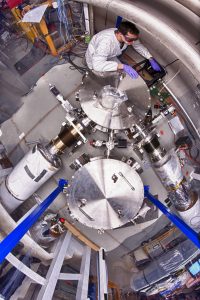
The Holometer is sensitive to high-frequency gravitational waves, allowing it to look for events such as cosmic strings. Photo: Reidar Hahn, Fermilab
Imagine an instrument that can measure motions a billion times smaller than an atom that last a millionth of a second. Fermilab’s Holometer is currently the only machine with the ability to take these very precise measurements of space and time, and recently collected data has improved the limits on theories about exotic objects from the early universe.
Our universe is as mysterious as it is vast. According to Albert Einstein’s theory of general relativity, anything that accelerates creates gravitational waves, which are disturbances in the fabric of space and time that travel at the speed of light and continue infinitely into space. Scientists are trying to measure these possible sources all the way to the beginning of the universe.
The Holometer experiment, based at the Department of Energy’s Fermilab, is sensitive to gravitational waves at frequencies in the range of a million cycles per second. Thus it addresses a spectrum not covered by experiments such as the Laser Interferometer Gravitational-Wave Observatory, which searches for lower-frequency waves to detect massive cosmic events such as colliding black holes and merging neutron stars.
“It’s a huge advance in sensitivity compared to what anyone had done before,” said Craig Hogan, director of the Center for Particle Astrophysics at Fermilab.
This unique sensitivity allows the Holometer to look for exotic sources that could not otherwise be found. These include tiny black holes and cosmic strings, both possible phenomena from the early universe that scientists expect to produce high-frequency gravitational waves. Tiny black holes could be less than a meter across and orbit each other a million times per second; cosmic strings are loops in space-time that vibrate at the speed of light.
The Holometer is composed of two Michelson interferometers that each split a laser beam down two 40-meter arms. The beams reflect off the mirrors at the ends of the arms and travel back to reunite. Passing gravitational waves alter the lengths of the beams’ paths, causing fluctuations in the laser light’s brightness, which physicists can detect.
The Holometer team spent five years building the apparatus and minimizing noise sources to prepare for experimentation. Now the Holometer is taking data continuously, and with an hour’s worth of data, physicists were able to confirm that there are no high-frequency gravitational waves at the magnitude where they were searching.
The absence of a signal provides valuable information about our universe. Although this result does not prove whether the exotic objects exist, it has eliminated the region of the universe where they could be present.
“It means that if there are primordial cosmic string loops or tiny black hole binaries, they have to be far away,” Hogan said. “It puts a limit on how much of that stuff can be out there.”
Detecting these high-frequency gravitational waves is a secondary goal of the Holometer. Its main purpose is to determine whether our universe acts like a 2-D hologram, where information is coded into two-dimensional bits at the Planck scale, a length around ten trillion trillion times smaller than an atom. That investigation is still in progress.
“For me, it’s gratifying to be able to contribute something new to science,” said researcher Bobby Lanza, who recently earned his Ph.D. conducting research on the Holometer. He is the lead author on an upcoming paper about the result. “It’s part of chipping away at the whole picture of the universe.”
EDITOR’S NOTE: The following news release about the restart of the Large Hadron Colider is being issued by the U.S. Department of Energy’s Fermi National Accelerator Laboratory on behalf of the U.S. scientists working on the LHC. Fermilab serves as the U.S. hub for the CMS experiment at the LHC and the roughly 1,000 U.S. scientists who work on that experiment, including about 100 Fermilab employees. Fermilab is a Tier 1 computing center for LHC data and hosts a Remote Operations Center to process and analyze that data. Get more information about Fermilab’s role in the CMS experiment and the LHC. See a list of Fermilab scientists who can speak about the LHC.
Earlier today, the world’s most powerful particle accelerator began its second act. After two years of upgrades and repairs, proton beams once again circulated around the Large Hadron Collider, located at the CERN laboratory near Geneva, Switzerland.
With the collider back in action, the more than 1,700 U.S. scientists who work on LHC experiments are prepared to join thousands of their international colleagues to study the highest-energy particle collisions ever achieved in the laboratory.
These collisions – hundreds of millions of them every second – will lead scientists to new and unexplored realms of physics and could yield extraordinary insights into the nature of the physical universe.
A highlight of the LHC’s first run, which began in 2009, was the discovery of the Higgs boson, the last in the suite of elementary particles that make up scientists’ best picture of the universe and how it works. The discovery of the Higgs was announced in July 2012 by two experimental collaborations, ATLAS and CMS. Continuing to measure the properties of the Higgs will be a major focus of LHC Run 2.
“The Higgs discovery was one of the most important scientific achievements of our time,” said James Siegrist, the U.S. Department of Energy’s associate director of science for high-energy physics. “With the LHC operational again, at even higher energies, the possibilities for new discoveries are endless, and the United States will be at the forefront of those discoveries.”
During the LHC’s second run, particles will collide at a staggering 13 teraelectronvolts (TeV), which is 60 percent higher than any accelerator has achieved before. The LHC’s four major particle detectors – ATLAS, CMS, ALICE and LHCb – will collect and analyze data from these collisions, allowing them to probe new areas of research that were previously unattainable.
At 17 miles around, the Large Hadron Collider is one of the largest machines ever built. The United States played a vital role in the construction of the LHC and the huge and intricate detectors for its experiments. Seven U.S. Department of Energy national laboratories joined roughly 90 U.S. universities to build key components of the accelerator, detectors and computing infrastructure, with funding from the DOE Office of Science and the National Science Foundation.
The U.S. contingent was part of an estimated 10,000 people from 113 different countries who helped to design, build and upgrade the LHC accelerator and its four particle detectors.
“We are on the threshold of an exciting time in particle physics: The LHC will turn on with the highest-energy beam ever achieved,” said Fleming Crim, National Science Foundation assistant director for mathematical and physical sciences. “This energy regime will open the door to new discoveries about our universe that were impossible as recently as two years ago.”
In addition to the scientists pushing toward new discoveries on the four main experiments, the United States provides a significant portion of the computing and data analysis – roughly 23 percent for ATLAS and 33 percent for CMS. U.S. scientists on the ALICE experiment developed control and tracking systems for the detector and made significant contributions in software, hardware and computing support. U.S. scientists also helped improve trigger software for data analysis for the LHCb experiment.
U.S. institutions will continue to make important contributions to the LHC and its experiments, even beyond the second run, which is scheduled to continue through the middle of 2018. Universities and national laboratories are developing new accelerator and detector technology for future upgrades of the LHC and its experiments. This ongoing work encourages a strong partnership between science and industry and drives technological innovation in the United States.
“Operating accelerators for the benefit of the physics community is what CERN’s here for,” said CERN Director General Rolf Heuer. “Today, CERN’s heart beats once more to the rhythm of the LHC.”
For more information on the U.S. role in the Large Hadron Collider, visit the USLHC website. For a series of videos on the LHC featuring U.S. scientists, visit this YouTube playlist.
For the CERN press release on the restart of the LHC, please click here.
CERN, the European Organization for Nuclear Research, is the world’s leading laboratory for particle physics. It has its headquarters in Geneva. At present, its Member States are Austria, Belgium, Bulgaria, the Czech Republic, Denmark, Finland, France, Germany, Greece, Hungary, Israel, Italy, the Netherlands, Norway, Poland, Portugal, Slovakia, Spain, Sweden, Switzerland and the United Kingdom. Romania is a Candidate for Accession. Serbia is an Associate Member in the pre-stage to Membership. India, Japan, the Russian Federation, the United States of America, Turkey, the European Union, JINR and UNESCO have Observer Status.
Fermilab is America’s premier national laboratory for particle physics and accelerator research. A U.S. Department of Energy Office of Science laboratory, Fermilab is located near Chicago, Illinois, and operated under contract by the Fermi Research Alliance LLC. Visit Fermilab’s website at www.fnal.gov and follow us on Twitter at @Fermilab.
The DOE Office of Science is the single largest supporter of basic research in the physical sciences in the United States and is working to address some of the most pressing challenges of our time. For more information, please visit science.energy.gov.
The National Science Foundation (NSF) is an independent federal agency that supports fundamental research and education across all fields of science and engineering. In fiscal year (FY) 2015, its budget is $7.3 billion. NSF funds reach all 50 states through grants to nearly 2,000 colleges, universities and other institutions. Each year, NSF receives about 48,000 competitive proposals for funding, and makes about 11,000 new funding awards. NSF also awards about $626 million in professional and service contracts yearly.
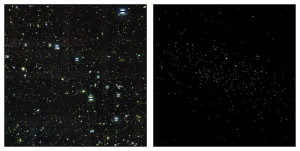
These two images allow you to see how difficult it is to spot these dwarf galaxy candidates in the Dark Energy Camera’s images. The first image is a snapshot of DES J0335.6-5403, a celestial object found with the Dark Energy Camera. It is the most likely of the newly discovered candidates to be a galaxy, according to DES scientists. This object sits roughly 100,000 light-years from Earth, and contains very few stars – only about 300 could be detected with DES data. The second image shows the detectable stars that likely belong to this object, with all other visible matter blacked out. Dwarf satellite galaxies are so faint that it takes an extremely sensitive instrument like the Dark Energy Camera to find them. More analysis is required to confirm if any of the newly discovered objects are in fact galaxies. Image: Fermilab/Dark Energy Survey
Scientists on two continents have independently discovered a set of celestial objects that seem to belong to the rare category of dwarf satellite galaxies orbiting our home galaxy, the Milky Way.
Dwarf galaxies are the smallest known galaxies, and they could hold the key to understanding dark matter and the process by which larger galaxies form.
A team of researchers with the Dark Energy Survey, headquartered at the U.S. Department of Energy’s Fermi National Accelerator Laboratory, and an independent group from the University of Cambridge jointly announced their findings today. Both teams used data taken during the first year of the Dark Energy Survey, all of which is publicly available, to carry out their analysis.
“The large dark matter content of Milky Way satellite galaxies makes this a significant result for both astronomy and physics,” said Alex Drlica-Wagner of Fermilab, one of the leaders of the Dark Energy Survey analysis.
Satellite galaxies are small celestial objects that orbit larger galaxies, such as our own Milky Way. Dwarf galaxies can be found with fewer than 100 stars and are remarkably faint and difficult to spot. (By contrast, the Milky Way, an average-sized galaxy, contains billions of stars.)
These newly discovered objects are a billion times dimmer than the Milky Way and a million times less massive. The closest of them is about 100,000 light-years away.
“The discovery of so many satellites in such a small area of the sky was completely unexpected,” said Cambridge’s Institute of Astronomy’s Sergey Koposov, the Cambridge study’s lead author. “I could not believe my eyes.”
Scientists have previously found more than two dozen of these satellite galaxies around our Milky Way. About half of them were discovered in 2005 and 2006 by the Sloan Digital Sky Survey, the precursor to the Dark Energy Survey. After that initial explosion of discoveries, the rate fell to a trickle and dropped off entirely over the past five years.
The Dark Energy Survey is looking at a new portion of the southern hemisphere, covering a different area of sky than the Sloan Digital Sky Survey. The galaxies announced today were discovered in a search of only the first of the planned five years of Dark Energy Survey data, covering roughly one-third of the portion of sky that DES will study. Scientists expect that the full Dark Energy Survey will find up to 30 of these satellite galaxies within its area of study.
While more analysis is required to confirm any of the observed celestial objects as satellite galaxies, researchers note their size, low surface brightness and significant distance from the center of the Milky Way as evidence that they are excellent candidates. Further tests are ongoing, and data collected during the second year of the Dark Energy Survey could yield more of these potential dwarf galaxies to study.
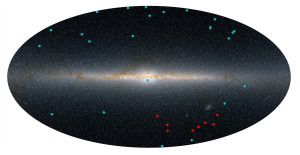
This illustration maps out the previously discovered dwarf satellite galaxies (in blue) and the newly discovered candidates (in red) as they sit outside the Milky Way. Image: Yao-Yuan Mao, Ralf Kaehler, Risa Wechsler (KIPAC/SLAC).
Atlas image obtained as part of the Two Micron All Sky Survey (2MASS), a joint project of the University of Massachusetts and the Infrared Processing and Analysis Center/California Institute of Technology, funded by the National Aeronautics and Space Administration and the National Science Foundation.
Newly discovered galaxies would also present scientists with more opportunities to search for signatures of dark matter. Dwarf satellite galaxies are dark matter-dominated, meaning they have much more mass in unseen matter than in stars. The nature of this dark matter remains unknown but might consist of particles that annihilate each other and release gamma rays. Because dwarf galaxies do not host other gamma ray sources, they make ideal laboratories to search for signs of dark matter annihilation. Scientists are confident that further study of these objects will lead to even more sensitive searches for dark matter.
In a separate result also announced today, the Large Area Telescope Collaboration for NASA’s Fermi Gamma-Ray Telescope mission reported that they did not see any significant excess of gamma ray emission associated with the new Dark Energy Survey objects. This result demonstrates that new discoveries from optical telescopes can be quickly translated into tests of fundamental physics.
“We did not detect significant emission with the LAT, but the dwarf galaxies that DES has and will discover are extremely important targets for the dark matter search,” said Peter Michelson, spokesperson for the LAT collaboration. “If not leading to an identification of particle dark matter, they will certainly be useful to constrain its properties.”
The Dark Energy Survey is a five-year effort to photograph a large portion of the southern sky in unprecedented detail. Its primary instrument is the Dark Energy Camera, which – at 570 megapixels – is the most powerful digital camera in the world, able to see galaxies up to 8 billion light-years from Earth. Built and tested at Fermilab, the camera is now mounted on the 4-meter Victor M. Blanco telescope at the Cerro Tololo Inter-American Observatory in the Andes Mountains in Chile.
The survey’s five-year mission is to discover clues about the nature of dark energy, the mysterious force that makes up about 70 percent of all matter and energy in the universe. Scientists believe that dark energy may be the key to understanding why the expansion of the universe is accelerating.
“The Dark Energy Camera is a perfect instrument for discovering small satellite galaxies,” said Keith Bechtol of the Kavli Institute for Cosmological Physics at the University of Chicago, who helped lead the Dark Energy Survey analysis. “It has a very large field of view to quickly map the sky and great sensitivity, enabling us to look at very faint stars. These results show just how powerful the camera is and how significant the data it collects will be for many years to come.”
The Dark Energy Survey analysis is available here. The University of Cambridge analysis is available here.
The Dark Energy Survey is a collaboration of more than 300 scientists from 25 institutions in six countries. For more information about the survey, please visit the experiment’s website.
Funding for the DES Projects has been provided by the U.S. Department of Energy, the U.S. National Science Foundation, the Ministry of Science and Education of Spain, the Science and Technology Facilities Council of the United Kingdom, the Higher Education Funding Council for England, the National Center for Supercomputing Applications at the University of Illinois at Urbana-Champaign, the Kavli Institute of Cosmological Physics at the University of Chicago, Financiadora de Estudos e Projetos, Fundação Carlos Chagas Filho de Amparo à Pesquisa do Estado do Rio de Janeiro, Conselho Nacional de Desenvolvimento Científico e Tecnológico and the Ministério da Ciência e Tecnologia, the Deutsche Forschungsgemeinschaft and the collaborating institutions in the Dark Energy Survey. The DES participants from Spanish institutions are partially supported by MINECO under grants AYA2012-39559, ESP2013-48274, FPA2013-47986 and Centro de Excelencia Severo Ochoa SEV-2012-0234, some of which include ERDF funds from the European Union.
Fermilab is America’s premier national laboratory for particle physics and accelerator research. A U.S. Department of Energy Office of Science laboratory, Fermilab is located near Chicago, Illinois, and operated under contract by the Fermi Research Alliance, LLC. Visit Fermilab’s website at www.fnal.gov and follow us on Twitter at @Fermilab.
The DOE Office of Science is the single largest supporter of basic research in the physical sciences in the United States and is working to address some of the most pressing challenges of our time. For more information, please visit science.energy.gov .
The mission of the University of Cambridge is to contribute to society through the pursuit of education, learning and research at the highest international levels of excellence. To date, 90 affiliates of the university have won the Nobel Prize. Founded in 1209, the university comprises 31 autonomous colleges, which admit undergraduates and provide small-group tuition, and 150 departments, faculties and institutions. Cambridge is a global university. Its 19,000 student body includes 3,700 international students from 120 countries. Cambridge researchers collaborate with colleagues worldwide, and the university has established larger-scale partnerships in Asia, Africa and America. The university sits at the heart of one of the world’s largest technology clusters. The ‘Cambridge Phenomenon’ has created 1,500 hi-tech companies, 14 of them valued at over US$1 billion and two at over US$10 billion. Cambridge promotes the interface between academia and business and has a global reputation for innovation. www.cam.ac.uk .
ESnet to build high-speed extension for faster data exchange between United States and Europe
Scientists across the Unit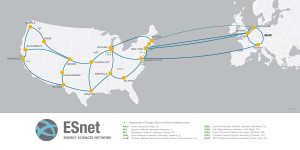 ed States will soon have access to new, ultra-high-speed network links spanning the Atlantic Ocean thanks to a project currently under way to extend ESnet (the U.S. Department of Energy’s Energy Sciences Network) to Amsterdam, Geneva and London. Although the project is designed to benefit data-intensive science throughout the U.S. national laboratory complex, heaviest users of the new links will be particle physicists conducting research at the Large Hadron Collider (LHC), the world’s largest and most powerful particle collider. The high capacity of this new connection will provide U.S. scientists with enhanced access to data at the LHC and other European-based experiments by accelerating the exchange of data sets between institutions in the United States and computing facilities in Europe.
ed States will soon have access to new, ultra-high-speed network links spanning the Atlantic Ocean thanks to a project currently under way to extend ESnet (the U.S. Department of Energy’s Energy Sciences Network) to Amsterdam, Geneva and London. Although the project is designed to benefit data-intensive science throughout the U.S. national laboratory complex, heaviest users of the new links will be particle physicists conducting research at the Large Hadron Collider (LHC), the world’s largest and most powerful particle collider. The high capacity of this new connection will provide U.S. scientists with enhanced access to data at the LHC and other European-based experiments by accelerating the exchange of data sets between institutions in the United States and computing facilities in Europe.
DOE’s Brookhaven National Laboratory and Fermi National Accelerator Laboratory—the primary computing centers for U.S. collaborators on the LHC’s ATLAS and CMS experiments, respectively—will make immediate use of the new network infrastructure once it is rigorously tested and commissioned. Because ESnet, based at DOE’s Lawrence Berkeley National Laboratory, interconnects all national laboratories and a number of university-based projects in the United States, tens of thousands of researchers from all disciplines will benefit as well.
The ESnet extension will be in place before the LHC at CERN in Switzerland—currently shut down for maintenance and upgrades—is up and running again in the spring of 2015. Because the accelerator will be colliding protons at much higher energy, the data output from the detectors will expand considerably—to approximately 40 petabytes of raw data per year compared with 20 petabytes for all of the previous lower-energy collisions produced over the three years of the LHC first run between 2010 and 2012.
The cross-Atlantic connectivity during the first successful run for the LHC experiments, which culminated in the discovery of the Higgs boson, was provided by the US LHCNet network, managed by the California Institute of Technology. In recent years, major research and education networks around the world—including ESnet, Internet2, California’s CENIC, and European networks such as DANTE, SURFnet and NORDUnet—have increased their backbone capacity by a factor of 10, using sophisticated new optical networking and digital signal processing technologies. Until recently, however, higher-speed links were not deployed for production purposes across the Atlantic Ocean—creating a network “impedance mismatch” that can harm large, intercontinental data flows.
An evolving data model
This upgrade coincides with a shift in the data model for LHC science. Previously, data moved in a more predictable and hierarchical pattern strongly influenced by geographical proximity, but network upgrades around the world have now made it possible for data to be fetched and exchanged more flexibly and dynamically. This change enables faster science outcomes and more efficient use of storage and computational power, but it requires networks around the world to perform flawlessly together.
“Having the new infrastructure in place will meet the increased need for dealing with LHC data and provide more agile access to that data in a much more dynamic fashion than LHC collaborators have had in the past,” said physicist Michael Ernst of DOE’s Brookhaven National Laboratory, a key member of the team laying out the new and more flexible framework for exchanging data between the Worldwide LHC Computing Grid centers.
Ernst directs a computing facility at Brookhaven Lab that was originally set up as a central hub for U.S. collaborators on the LHC’s ATLAS experiment. A similar facility at Fermi National Accelerator Laboratory has played this role for the LHC’s U.S. collaborators on the CMS experiment. These computing resources, dubbed Tier 1 centers, have direct links to the LHC at the European laboratory CERN (Tier 0). The experts who run them will continue to serve scientists under the new structure. But instead of serving as hubs for data storage and distribution only among U.S.-based collaborators at Tier 2 and 3 research centers, the dedicated facilities at Brookhaven and Fermilab will be able to serve data needs of the entire ATLAS and CMS collaborations throughout the world. And likewise, U.S. Tier 2 and Tier 3 research centers will have higher-speed access to Tier 1 and Tier 2 centers in Europe.
“This new infrastructure will offer LHC researchers at laboratories and universities around the world faster access to important data,” said Fermilab’s Lothar Bauerdick, head of software and computing for the U.S. CMS group. “As the LHC experiments continue to produce exciting results, this important upgrade will let collaborators see and analyze those results better than ever before.”
Ernst added, “As centralized hubs for handling LHC data, our reliability, performance and expertise have been in demand by the whole collaboration, and now we will be better able to serve the scientists’ needs.”
An investment in science
ESnet is funded by DOE’s Office of Science to meet networking needs of DOE labs and science projects. The transatlantic extension represents a financial collaboration, with partial support coming from DOE’s Office of High Energy Physics (HEP) for the next three years. Although LHC scientists will get a dedicated portion of the new network once it is in place, all science programs that make use of ESnet will now have access to faster network links for their data transfers.
“We are eagerly awaiting the start of commissioning for the new infrastructure,” said Oliver Gutsche, Fermilab scientist and member of the CMS Offline and Computing Management Board. “After the Higgs discovery, the next big LHC milestones will come in 2015, and this network will be indispensable for the success of the LHC Run 2 physics program.”
This work was supported by the DOE Office of Science.
Fermilab is America’s premier national laboratory for particle physics and accelerator research. A U.S. Department of Energy Office of Science laboratory, Fermilab is located near Chicago, Illinois, and operated under contract by the Fermi Research Alliance, LLC. Visit Fermilab’s website at www.fnal.gov and follow us on Twitter at @FermilabToday.
Brookhaven National Laboratory is supported by the Office of Science of the U.S. Department of Energy. The Office of Science is the single largest supporter of basic research in the physical sciences in the United States, and is working to address some of the most pressing challenges of our time. For more information, please visit science.energy.gov.
One of ten national laboratories overseen and primarily funded by the Office of Science of the U.S. Department of Energy (DOE), Brookhaven National Laboratory conducts research in the physical, biomedical, and environmental sciences, as well as in energy technologies and national security. Brookhaven Lab also builds and operates major scientific facilities available to university, industry and government researchers. Brookhaven is operated and managed for DOE’s Office of Science by Brookhaven Science Associates, a limited-liability company founded by the Research Foundation for the State University of New York on behalf of Stony Brook University, the largest academic user of Laboratory facilities, and Battelle, a nonprofit applied science and technology organization.
Visit Brookhaven Lab’s electronic newsroom for links, news archives, graphics, and more at http://www.bnl.gov/newsroom, follow Brookhaven Lab on Twitter, http://twitter.com/BrookhavenLab, or find us on Facebook, http://www.facebook.com/BrookhavenLab/.
The DOE Office of Science is the single largest supporter of basic research in the physical sciences in the United States and is working to address some of the most pressing challenges of our time. For more information, please visit science.energy.gov.
With construction completed, the NOvA experiment has begun its probe into the mysteries of ghostly particles that may hold the key to understanding the universe
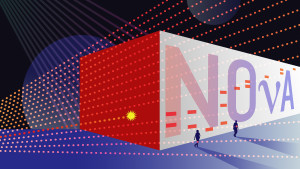 It’s the most powerful accelerator-based neutrino experiment ever built in the United States and the longest-distance one in the world. It’s called NOvA, and after nearly five years of construction, scientists are now using the two massive detectors – placed 500 miles apart – to study one of nature’s most elusive subatomic particles.
It’s the most powerful accelerator-based neutrino experiment ever built in the United States and the longest-distance one in the world. It’s called NOvA, and after nearly five years of construction, scientists are now using the two massive detectors – placed 500 miles apart – to study one of nature’s most elusive subatomic particles.
Scientists believe that a better understanding of neutrinos, one of the most abundant and difficult-to-study particles, may lead to a clearer picture of the origins of matter and the inner workings of the universe. Using the world’s most powerful beam of neutrinos, generated at the U.S. Department of Energy’s Fermi National Accelerator Laboratory near Chicago, the NOvA experiment can precisely record the telltale traces of those rare instances when one of these ghostly particles interacts with matter.
Construction on NOvA’s two massive neutrino detectors began in 2009. In September, the Department of Energy officially proclaimed construction of the experiment completed, on schedule and under budget.
“Congratulations to the NOvA collaboration for successfully completing the construction phase of this important and exciting experiment,” said James Siegrist, DOE associate director of science for high energy physics. “With every neutrino interaction recorded, we learn more about these particles and their role in shaping our universe.”
NOvA’s particle detectors were both constructed in the path of the neutrino beam sent from Fermilab in Batavia, Illinois, to northern Minnesota. The 300-ton near detector, installed underground at the laboratory, observes the neutrinos as they embark on their near-light-speed journey through the Earth, with no tunnel needed. The 14,000-ton far detector — constructed in Ash River, Minnesota, near the Canadian border – spots those neutrinos after their 500-mile trip and allows scientists to analyze how they change over that long distance.
For the next six years, Fermilab will send tens of thousands of billions of neutrinos every second in a beam aimed at both detectors, and scientists expect to catch only a few each day in the far detector, so rarely do neutrinos interact with matter.
From this data, scientists hope to learn more about how and why neutrinos change between one type and another. The three types, called flavors, are the muon, electron and tau neutrino. Over longer distances, neutrinos can flip between these flavors. NOvA is specifically designed to study muon neutrinos changing into electron neutrinos. Unraveling this mystery may help scientists understand why the universe is composed of matter and why that matter was not annihilated by antimatter after the big bang.
Scientists will also probe the still-unknown masses of the three types of neutrinos in an attempt to determine which is the heaviest.
“Neutrino research is one of the cornerstones of Fermilab’s future and an important part of the worldwide particle physics program,” said Fermilab Director Nigel Lockyer. “We’re proud of the NOvA team for completing the construction of this world-class experiment, and we’re looking forward to seeing the first results in 2015.”
The far detector in Minnesota is believed to be the largest free-standing plastic structure in the world, at 200 feet long, 50 feet high and 50 feet wide. Both detectors are constructed from PVC and filled with a scintillating liquid that gives off light when a neutrino interacts with it. Fiber optic cables transmit that light to a data acquisition system, which creates 3-D pictures of those interactions for scientists to analyze.
The NOvA far detector in Ash River saw its first long-distance neutrinos in November 2013. The far detector is operated by the University of Minnesota under an agreement with Fermilab, and students at the university were employed to manufacture the component parts of both detectors.
“Building the NOvA detectors was a wide-ranging effort that involved hundreds of people in several countries,” said Gary Feldman, co-spokesperson of the NOvA experiment. “To see the construction completed and the operations phase beginning is a victory for all of us and a testament to the hard work of the entire collaboration.”
The NOvA collaboration comprises 208 scientists from 38 institutions in the United States, Brazil, the Czech Republic, Greece, India, Russia and the United Kingdom. The experiment receives funding from the U.S. Department of Energy, the National Science Foundation and other funding agencies.
For more information, visit the experiment’s website: http://www-nova.fnal.gov.
Note: NOvA stands for NuMI Off-Axis Electron Neutrino Appearance. NuMI is itself an acronym, standing for Neutrinos from the Main Injector, Fermilab’s flagship accelerator.
Fermilab is America’s premier national laboratory for particle physics and accelerator research. A U.S. Department of Energy Office of Science laboratory, Fermilab is located near Chicago, Illinois, and operated under contract by the Fermi Research Alliance, LLC. Visit Fermilab’s website at www.fnal.gov and follow us on Twitter at @Fermilab.
The DOE Office of Science is the single largest supporter of basic research in the physical sciences in the United States and is working to address some of the most pressing challenges of our time. For more information, please visit science.energy.gov.
- A view across the top of the NOvA far detector in Ash River, Minnesota. Electronics that make up part of the data acquisition system are installed along the top and sides of the detector. The far detector measures roughly 200 feet long, 50 feet high and 50 feet wide, and is made of PVC filled with a scintillating oil. Neutrino interactions inside the detector create light, which travels up fiber optic cables to the banks of computers. Photo: Fermilab.
- The massive pivoting machine moves one block of the NOvA far detector across the hall in Ash River, Minnesota, to connect it with the rest of the detector. Each block measures 50 feet by 50 feet by 6 feet, and was assembled from PVC modules crafted by University of Minnesota students. Photo: Fermilab.
- A worker guides a completed module of the NOvA far detector into place, joining it with the rest of the detector. The completed detector, built in Ash River, Minnesota, measures roughly 200 feet by 50 feet by 50 feet. Each new module was constructed on the massive pivoting machine and slowly maneuvered into place. Photo: Fermilab.
- A man stands near the partially completed NOvA far detector in Ash River, Minnesota. The detector, constructed entirely of PVC, stands 50 feet tall and 50 feet wide. The completed detector is roughly 200 feet long. The NOvA team received final DOE approval for the completed detector in September 2014. Photo: Fermilab.
- The NOvA near detector, built underground at Fermilab in Batavia, Illinois, is roughly 47 feet long, 14 feet high and 10 feet wide. It is constructed of the same material as the far detector. Photo: Fermilab.
- A graphic representation of one of the first neutrino interactions captured at the NOvA far detector in northern Minnesota. The dotted red line represents the neutrino beam, generated at Fermilab in Illinois and sent through 500 miles of earth to the far detector. The image on the left is a simplified 3-D view of the detector, the top right view shows the interaction from the top of the detector, and the bottom right view shows the interaction from the side of the detector. Illustration courtesy of Fermilab.
- Data collected at the NOvA far detector in northern Minnesota shows one of the first interactions captured at that detector from a beam of man-made neutrinos. The neutrino beam is generated at Fermilab in Illinois and then sent through 500 miles of earth to the far detector. Image courtesy of NOvA collaboration.
Calling all nature lovers. How would you like the chance to help diversify one of the oldest prairie restorations in Illinois?
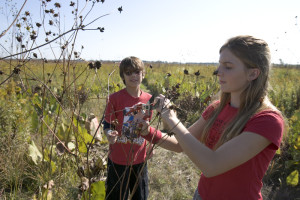 The U.S. Department of Energy’s Fermi National Accelerator Laboratory is looking for volunteers to help with its annual Prairie Seed Harvest. Two harvest events are planned, on Saturday, Oct. 4, and Saturday, Nov. 1, beginning at 10 a.m. Fermilab’s site hosts 1,000 acres of restored native prairie land, and each year community members pitch in to help collect seeds from those native plants.
The U.S. Department of Energy’s Fermi National Accelerator Laboratory is looking for volunteers to help with its annual Prairie Seed Harvest. Two harvest events are planned, on Saturday, Oct. 4, and Saturday, Nov. 1, beginning at 10 a.m. Fermilab’s site hosts 1,000 acres of restored native prairie land, and each year community members pitch in to help collect seeds from those native plants.
Less than one-tenth of one percent of native prairies in Illinois remains intact. Fermilab’s restored grassland is one of the largest prairies in the state. The deep-rooted natural grasses of the prairie help prevent erosion and preserve the area’s aquifers.
The main collection area encompasses about 100 acres, and within it, volunteers will gather seeds from about 25 different types of native plants. Some of those seeds will be used to replenish the Fermilab prairies, filling in gaps where some species are more dominant than others.
“Our objective is to collect seeds from dozens of species,” said Ryan Campbell, an ecologist at Fermilab. “We have more than 1,000 acres of restored grassland, and it’s not all of the same quality. We want to spread diversity throughout the whole site.”
Once the seeds have been collected, the Fermilab Roads and Grounds staff will store them in a greenhouse and process them for springtime planting, after controlled burns of the prairie have been conducted. The laboratory has donated some of the seeds to area schools for use in their own prairies and as educational tools.
Fermilab has been hosting the Prairie Seed Harvest every year since 1974, and it typically draws more than 200 volunteers. Both of this year’s events will last from 10 a.m. to 2 p.m., with lunch provided. Volunteers will be trained on different types of plants and how to harvest seeds. If you have them, bring gloves, a pair of hand clippers and paper grocery bags.
In case of inclement weather, call the Fermilab switchboard at 630-840-3000 to check whether the Prairie Seed Harvest has been canceled. More information on Fermilab’s prairie can be found at http://www.fnal.gov/pub/about/campus/ecology/prairie. For more information on the Prairie Seed Harvest, call the Fermilab Roads and Grounds Department at 630-840-3303.
Fermilab is America’s premier national laboratory for particle physics and accelerator research. A U.S. Department of Energy Office of Science laboratory, Fermilab is located near Chicago, Illinois, and operated under contract by the Fermi Research Alliance LLC. Visit Fermilab’s website at www.fnal.gov and follow us on Twitter at @FermilabToday.
The DOE Office of Science is the single largest supporter of basic research in the physical sciences in the United States and is working to address some of the most pressing challenges of our time. For more information, please visit science.energy.gov.

